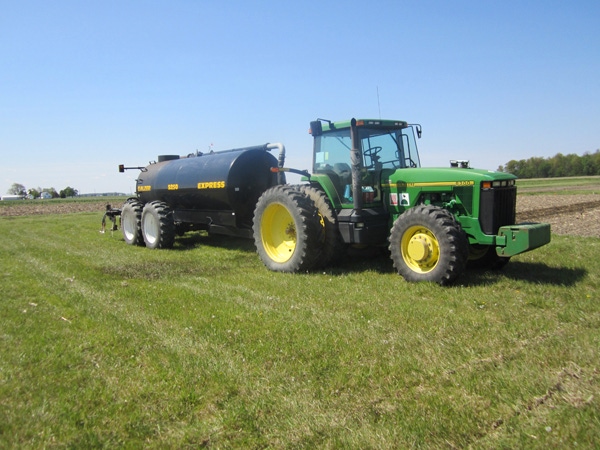April 9, 2013

Applications of liquid manures have the potential to provide nitrogen (N) that can be counted toward meeting the needs of the corn crop and substituting for 28% or other fertilizer N sources. Research on the application of manure preplant or sidedress to corn has been ongoing in Ohio for several years. Liquid swine and dairy manure were applied to pre-emergent and post-emergent corn at the OARDC Hoytville research station in 2011 and 2012.
The N content of livestock manure can be determined by submitting a sample for testing. Testing revealed the swine manure source for this research plot contained approximately 38 lbs. of available N/1,000 gal. The dairy manure source contained approximately 10 lbs. available N/1,000 gal.
In 2011, a total N rate of 175 lbs. from all sources was used. An application rate of 4,700 gal./acre of swine manure was used. A dairy manure application rate of 13,577 gal. provided 135 units of B with supplemental 28% UAN applied just prior to the dairy manure application to reach the 175 lbs. Corn was planted on June 3in 2011. Pre-emergent manure applications were made on June 6 and post-emergent manure applications were made on June 16. All treatments received 175 lbs./acre of N.
In 2012, a total N rate of 200 lbs. from all sources was used. An application rate of 5,200 gal./acre of swine manure was used. A dairy manure application rate of 13,577 gal./acre provided 135 units of N. The dairy reps received additional N incorporated as supplemental 28% UAN applied just prior to the dairy manure application to reach the 200-lb. N rate.
Corn was planted on April 26. Pre-emergent manure applications were made on April 27 and post-emergent manure applications were made on May 16. All treatments received 200 lbs./acre of N.
Dry weather in June and early July of 2011 severely reduced corn yields on the 28% UAN sidedress plots. The liquid added by the swine and dairy manure likely helped the early growth of the corn. The manure moisture also appeared to improved control of knotweed at the site, which may have reduced weed pressure.
Like what you're reading? Subscribe to CSD Extra and get the latest news right to your inbox!
The 2012 growing season was also unusually dry. Again, the moisture added by the manure probably benefitted the overall manure treatment yields.
Stand populations were approximately 28,000 plants/acre across all treatments. The manure did not appear to reduce the plot stands in either year.
All manure was applied with a 5,250-gal. tanker and Dietrich tool bar. Surface manure applications were accomplished by simply raising the toolbar out of the ground.
2011 & 2012 Corn-Manure Research Plots OARDC Northwest Branch
| 2011 | 2012 | Two-year average |
| Bu./acre | Bu./acre | Bu./acre |
Pre-emergent treatments |
|
|
|
Incorporated 28%UAN | 138.1 | 111.5 | 124.8 |
Incorporated swine manure | 191.9 | 128.6 | 160.3 |
Surface applied swine manure | 180.9 | 109.5 | 145.2 |
Incorporated dairy manure + 28%UAN | 190.1 | 132.0 | 161.1 |
Surface applied dairy manure + 28%UAN | 184.5 | 97.0 | 140.8 |
|
|
|
|
Post-emergent treatments |
|
|
|
Incorporated 28%UAN | 132.7 | 116.0 | 124.4 |
Incorporated swine manure | 180.8 | 138.4 | 159.6 |
Surface applied swine manure | 178.0 | 116.4 | 147.2 |
Incorporated dairy manure + 28%UAN | 180.0 | 138.8 | 159.4 |
Surface applied dairy manure + 28%UAN | 170.5 | 101.6 | 136.1 |
|
|
|
|
Zero nitrogen check | 74.4 | 62.6 | 68.5 |
| LSD= 16.99 | LSD=14.54 |
|
You might also like:
Sample this Spring for Soil Nitrogen
7 Steps for Managing Resistant Weeds
Q&A: How to Avoid Soil Compaction
You May Also Like




